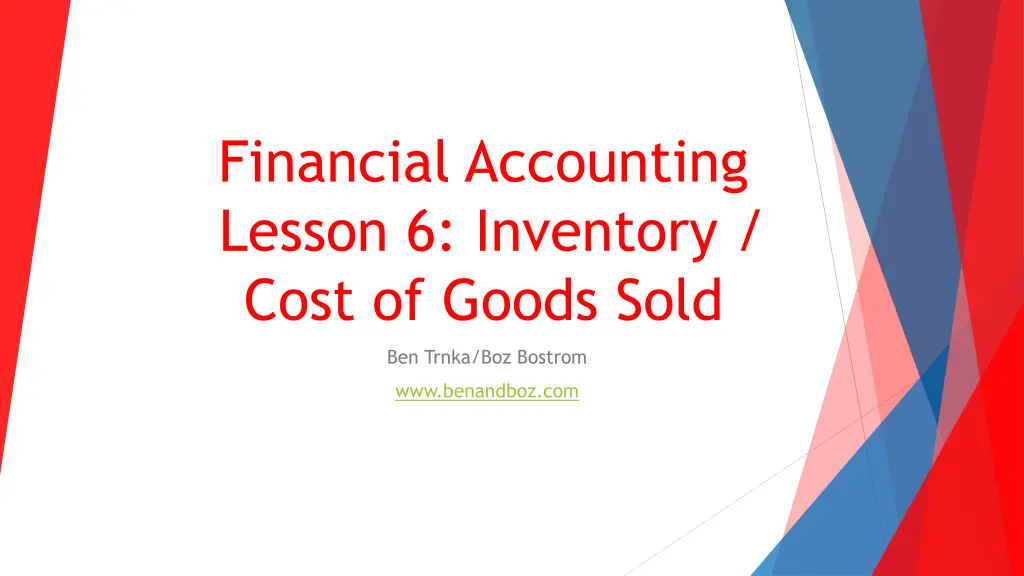
Fortune 500 Companies Inventory and COGS Analysis
Explore the inventory levels and cost of goods sold (COGS) of Fortune 500 companies like Walmart, Exxon Mobil, Berkshire Hathaway, Apple, and more. Understand the significance of managing inventory efficiently and how it impacts financial performance.
Download Presentation

Please find below an Image/Link to download the presentation.
The content on the website is provided AS IS for your information and personal use only. It may not be sold, licensed, or shared on other websites without obtaining consent from the author. If you encounter any issues during the download, it is possible that the publisher has removed the file from their server.
You are allowed to download the files provided on this website for personal or commercial use, subject to the condition that they are used lawfully. All files are the property of their respective owners.
The content on the website is provided AS IS for your information and personal use only. It may not be sold, licensed, or shared on other websites without obtaining consent from the author.
E N D
Presentation Transcript
Financial Accounting Lesson 6: Inventory / Cost of Goods Sold Ben Trnka/Boz Bostrom www.benandboz.com
COGS and Inventory are huge numbers for many companies!
Fortune 500 Inventory Levels? Company Walmart Exxon Mobil Berkshire Hathaway Apple UnitedHealth Group McKesson CVS Health Amazon.com AT&T General Motors Revenues $500B $244B $242B $229B $201B $199B $185B $178B $161B $157B Inventory Percent
Fortune 500 Inventory Levels! Company Walmart Exxon Mobil Berkshire Hathaway Apple UnitedHealth Group McKesson CVS Health Amazon.com AT&T General Motors Revenues $500B $244B $242B $229B $201B $199B $185B $178B $161B $157B Inventory $43.8B Percent 8.8%
Fortune 500 Inventory Levels! Company Walmart Exxon Mobil Berkshire Hathaway Apple UnitedHealth Group McKesson CVS Health Amazon.com AT&T General Motors Revenues $500B $244B $242B $229B $201B $199B $185B $178B $161B $157B Inventory $43.8B Percent 8.8% 7.0% $17B
Fortune 500 Inventory Levels! Company Walmart Exxon Mobil Berkshire Hathaway Apple UnitedHealth Group McKesson CVS Health Amazon.com AT&T General Motors Revenues $500B $244B $242B $229B $201B $199B $185B $178B $161B $157B Inventory $43.8B Percent 8.8% 7.0% 6.7% $17B $16.2B
Fortune 500 Inventory Levels! Company Walmart Exxon Mobil Berkshire Hathaway Apple UnitedHealth Group McKesson CVS Health Amazon.com AT&T General Motors Revenues $500B $244B $242B $229B $201B $199B $185B $178B $161B $157B Inventory $43.8B Percent 8.8% 7.0% 6.7% 2.1% $17B $16.2B $4.9B
Fortune 500 Inventory Levels! Company Walmart Exxon Mobil Berkshire Hathaway Apple UnitedHealth Group McKesson CVS Health Amazon.com AT&T General Motors Revenues $500B $244B $242B $229B $201B $199B $185B $178B $161B $157B Inventory $43.8B Percent 8.8% 7.0% 6.7% 2.1% 0.0% $17B $16.2B $4.9B $0B
Fortune 500 Inventory Levels! Company Walmart Exxon Mobil Berkshire Hathaway Apple UnitedHealth Group McKesson CVS Health Amazon.com AT&T General Motors Revenues $500B $244B $242B $229B $201B $199B $185B $178B $161B $157B Inventory $43.8B Percent 8.8% 7.0% 6.7% 2.1% 0.0% 8.2% $17B $16.2B $4.9B $0B $16.3B
Fortune 500 Inventory Levels! Company Walmart Exxon Mobil Berkshire Hathaway Apple UnitedHealth Group McKesson CVS Health Amazon.com AT&T General Motors Revenues $500B $244B $242B $229B $201B $199B $185B $178B $161B $157B Inventory $43.8B Percent 8.8% 7.0% 6.7% 2.1% 0.0% 8.2% 8.3% $17B $16.2B $4.9B $0B $16.3B $15.3B
Fortune 500 Inventory Levels! Company Walmart Exxon Mobil Berkshire Hathaway Apple UnitedHealth Group McKesson CVS Health Amazon.com AT&T General Motors Revenues $500B $244B $242B $229B $201B $199B $185B $178B $161B $157B Inventory $43.8B Percent 8.8% 7.0% 6.7% 2.1% 0.0% 8.2% 8.3% 9.0% $17B $16.2B $4.9B $0B $16.3B $15.3B $16B
Fortune 500 Inventory Levels! Company Walmart Exxon Mobil Berkshire Hathaway Apple UnitedHealth Group McKesson CVS Health Amazon.com AT&T General Motors Revenues $500B $244B $242B $229B $201B $199B $185B $178B $161B $157B Inventory $43.8B Percent 8.8% 7.0% 6.7% 2.1% 0.0% 8.2% 8.3% 9.0% 1.4% $17B $16.2B $4.9B $0B $16.3B $15.3B $16B $2.2B
Fortune 500 Inventory Levels! Company Walmart Exxon Mobil Berkshire Hathaway Apple UnitedHealth Group McKesson CVS Health Amazon.com AT&T General Motors Revenues $500B $244B $242B $229B $201B $199B $185B $178B $161B $157B Inventory $43.8B Percent 8.8% 7.0% 6.7% 2.1% 0.0% 8.2% 8.3% 9.0% 1.4% 6.8% $17B $16.2B $4.9B $0B $16.3B $15.3B $16B $2.2B $10.7B
Overview Understand relevant definitions related to inventories Understand the three main inventory costing methods and the impact on the financial statements Understand rationale behind selecting an inventory costing method
Definitions What is inventory? Goods/products owned by a company and held for sale Merchandisers Buy/sell finished products. Examples? Merchandise Inventory Manufacturers Produce goods. Examples? Raw Materials Work in Process Raw Materials Processed, Direct Labor, Factory Overhead Finished Products
Inventory Flows Inventory is debited when purchased Credit generally to cash or accounts payable Dr Inventory $100 Cr Cash $100 Inventory is credited when sold Debit to Cost of Goods Sold Dr COGS $100 Cr Inventory $100
Inventory Systems Perpetual Inventory levels adjusted each time a sale is made Inventory counts still occur at least once per year to compare expected and actual levels Why could they be different? Periodic Inventory levels not tracked on a real-time basis Inventory counts critical
Inventory / COGS formula Beginning inventory + Purchases = Goods Available for Sale - Ending Inventory = Cost of Goods Sold (COGS) Seems straight forward, but Ending Inventory may be computed many ways
Inventory Methods GAAP requires that a company choose and stick to an inventory valuation/costing method FIFO First-In, First-Out LIFO Last-In, First-Out Weighted Average Specific Identification
Base Facts Units 100 110 120 330 Per Unit $20 $21 $22 Dollars $2,000 $2,310 $2,640 $6,950 Beginning Purchase 1 Purchase 2 Goods Available for Sale Units Sold 200 $40 $8,000 Units in Ending Inventory 130
FIFO First-In, First-Out Units Per Unit Dollars Beginning 100 $20 $2,000 Purchase 1 110 $21 $2,310 Purchase 2 120 $22 $2,640 Goods Available for Sale 330 $6,950 Ending Inventory (130 units): 120 $22 $2,640 10 $21 $210 130 $2,850 COGS 200 $4,100
LIFO Last-In, First-Out Units Per Unit Dollars Beginning 100 $20 $2,000 Purchase 1 110 $21 $2,310 Purchase 2 120 $22 $2,640 Goods Available for Sale 330 $6,950 Ending Inventory (130 units): 100 $20 $2,000 30 $21 $630 130 $2,630 COGS 200 $4,320
Weighted Average Units Per Unit Dollars Beginning 100 $20 $2,000 Purchase 1 110 $21 $2,310 Purchase 2 120 $22 $2,640 Goods Available for Sale 330 $6,950 Goods Available for Sale in Dollars $6,950 = $21.0606 / unit Goods Available for Sale in Units 330 Ending Inventory 130 $21.0606 $2,738 COGS 200 $21.0606 $4,212
Summary FIFO $8,000 $4,100 $3,900 LIFO $8,000 $4,320 $3,680 Weighted Average $8,000 $4,212 $3,788 Sales COGS Gross Margin Ending Inventory $2,850 $2,630 $2,738 Important note: While the financial statements will look different, the economic value of the company is the same under each approach Under each approach, the company received $8,000 of cash and has 130 units of the product still on hand
Trends When inventory prices are rising, FIFO will have highest ending inventory, lowest COGS, and highest gross margin When inventory prices are decreasing, LIFO will have highest ending inventory, lowest COGS, and highest gross margin
Specific Identification More likely to be used by a company which sells very specific products Jewelers Home/Commercial Construction Companies Companies which make custom products Assume a jeweler has three rings in stock, which cost the jeweler $2,000, $3,500, and $5,200 respectively, and they sell the ring which cost $3,500. They will simply debit COGS and credit inventory for the $3,500 Other inventory methods would not make sense
Lower of Cost or Market If inventory has declined in value, a company may need to write-down the value of the inventory Companies should record inventory at the lower of: Cost at which inventory was purchased Net realizable value (Selling price less cost to sell) Example: Best Buy purchases a model of TV s from Sony for $500 apiece. One year later, Best Buy still has 100 TV s on hand and could only sell them for $400 apiece. The net realizable value of $400 is less than cost of $500. The journal entry to write down the inventory would be: Dr COGS $10,000 (($500-$400)*100) Cr Inventory $10,000
Tax Considerations Companies can choose different accounting methods for tax purposes In a period of inflation, companies would thus show lower profits and pay less in taxes by using LIFO for tax But if a company chooses LIFO for tax, it must also use LIFO for books So public companies need to weigh lower financial accounting profits vs. a lower tax bill Private companies which don t issue financial statements will often choose LIFO because of the tax benefits
BONUS SLIDE!!! LIFO Reserve If a company uses LIFO for books, it must disclose the LIFO Reserve Amount inventory would have been under FIFO COGS would thus have been different by this amount
Key Takeaways Inventory is debited when purchased, credited when sold. COGS is debited when inventory is sold The main inventory costing methods are FIFO, LIFO, and Weighted Average Under periods of inflation, FIFO will result in the lowest COGS and highest profit Choice of inventory method does not need to conform to actual flow of goods Choice of inventory method should not affect value of company Thanks for tuning in!






















